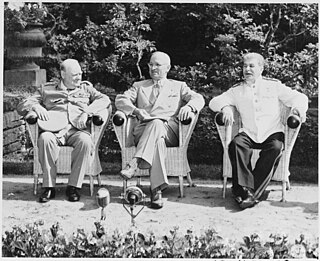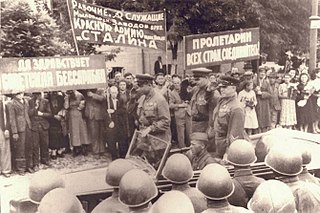
The Kellogg–Briand Pact or Pact of Paris – officially the General Treaty for Renunciation of War as an Instrument of National Policy – is a 1928 international agreement on peace in which signatory states promised not to use war to resolve "disputes or conflicts of whatever nature or of whatever origin they may be, which may arise among them". The pact was signed by Germany, France, and the United States on 27 August 1928, and by most other states soon after. Sponsored by France and the U.S., the Pact is named after its authors, United States Secretary of State Frank B. Kellogg and French foreign minister Aristide Briand. The pact was concluded outside the League of Nations and remains in effect.

The North Atlantic Treaty Organization, also called the North Atlantic Alliance, is an intergovernmental military alliance between 28 European countries and 2 North American countries. The organization implements the North Atlantic Treaty that was signed on 4 April 1949.

The Treaty on Open Skies establishes a program of unarmed aerial surveillance flights over the entire territory of its participants. The treaty is designed to enhance mutual understanding and confidence by giving all participants, regardless of size, a direct role in gathering information about military forces and activities of concern to them. It entered into force on January 1, 2002, and currently has 34 party states. The idea of allowing countries to openly surveil each other is thought to prevent misunderstandings and limit the escalation of tensions. It also provides mutual accountability for countries to follow through on treaty promises. Open Skies is one of the most wide-ranging international efforts to date promoting openness and transparency of military forces and activities.

The Potsdam Conference was held in Potsdam, Germany, from July 17 to August 2, 1945. The participants were the Soviet Union, the United Kingdom, and the United States, which were represented respectively by Premier Joseph Stalin, Prime Ministers Winston Churchill and Clement Attlee, and President Harry S. Truman. They gathered to decide how to administer Germany, which had agreed to an unconditional surrender nine weeks earlier, on the 8 May. The goals of the conference also included establishing the postwar order, solving issues on the peace treaty, and countering the effects of the war.

The Warsaw Treaty Organization (WTO), officially the Treaty of Friendship, Cooperation and Mutual Assistance, commonly known as the Warsaw Pact (WP), was a collective defense treaty signed in Warsaw, Poland between the Soviet Union and seven other Eastern Bloc socialist republics of Central and Eastern Europe in May 1955, during the Cold War. The Warsaw Pact was the military complement to the Council for Mutual Economic Assistance (CoMEcon), the regional economic organization for the socialist states of Central and Eastern Europe. The Warsaw Pact was created in reaction to the integration of West Germany into NATO in 1955 per the London and Paris Conferences of 1954.

The foreign relations of Yemen are the relationships and policies that Yemen maintains with other countries. It is a member of the United Nations, the Arab League, and the Organisation of Islamic Cooperation. Yemen participates in the nonaligned movement. The Republic of Yemen accepted responsibility for all treaties and debts of its predecessors, the YAR and the PDRY. Additionally, Yemen has acceded to the Nuclear Non-Proliferation Treaty and has stressed the need to render the Middle East region free of nuclear and other weapons of mass destruction.

The Axis powers, originally called the Rome–Berlin Axis, was a military coalition that fought in World War II against the Allies. The Axis powers agreed on their opposition to the Allies, but did not completely coordinate their activity.

The Tripartite Pact, also known as the Berlin Pact, was an agreement between Germany, Italy, and Japan signed in Berlin on 27 September 1940 by, respectively, Joachim von Ribbentrop, Galeazzo Ciano and Saburō Kurusu. It was a defensive military alliance that was eventually joined by Hungary, Romania, Bulgaria and Yugoslavia as well as by the German client state of Slovakia. Yugoslavia's accession provoked a coup d'état in Belgrade two days later. Germany, Italy and Hungary responded by invading Yugoslavia. The resulting Italo-German client state, known as the Independent State of Croatia, joined the pact on 15 June 1941.
Arms control is a term for international restrictions upon the development, production, stockpiling, proliferation and usage of small arms, conventional weapons, and weapons of mass destruction. Arms control is typically exercised through the use of diplomacy which seeks to impose such limitations upon consenting participants through international treaties and agreements, although it may also comprise efforts by a nation or group of nations to enforce limitations upon a non-consenting country.

The Treaty of Trianon was prepared at the Paris Peace Conference and was signed in the Grand Trianon Palace in Versailles on 4 June 1920. It formally ended World War I between most of the Allies of World War I and the Kingdom of Hungary. French diplomats played the major role in designing the treaty, with a mind to establishing a French-led coalition of the newly formed nations. It regulated the status of the independent Hungarian state and defined its borders generally within the ceasefire lines established in November–December 1918 and left Hungary as a landlocked state that included 93,073 square kilometres (35,936 sq mi), 28% of the 325,411 square kilometres (125,642 sq mi) that had constituted the pre-war Kingdom of Hungary. The truncated Kingdom had a population of 7.6 million, 36% compared to the pre-war kingdom's population of 20.9 million. Though the areas that were allocated to neighbouring countries had a majority of non-Hungarians, in them lived 3.3 million Hungarians – 31% – who were now in a minority status. The treaty limited Hungary's army to 35,000 officers and men, and the Austro-Hungarian Navy ceased to exist. These decisions and their consequences have been the cause of deep resentment in Hungary ever since.

The Little Entente was an alliance formed in 1920 and 1921 by Czechoslovakia, Romania and the Kingdom of Serbs, Croats and Slovenes with the purpose of common defense against Hungarian revanchism and the prospect of a Habsburg restoration. France supported the alliance by signing treaties with each member country. The rapid growth of German power caused its collapse in 1938, and it never went into wartime operation.
A secret treaty is a treaty in which the contracting state parties have agreed to conceal the treaty's existence or substance from other states and the public. Such a commitment to keep the agreement secret may be contained in the instrument itself or in a separate agreement.
Following the termination of hostilities in World War II, the Allies were in control of the defeated Axis countries. Anticipating the defeat of Germany and Japan, they had already set up the European Advisory Commission and a proposed Far Eastern Advisory Commission to make recommendations for the post war period. Accordingly, they managed their control of the defeated countries through Allied Commissions, often referred to as Allied Control Commissions (ACC), consisting of representatives of the major Allies.
The original Treaty on Conventional Armed Forces in Europe (CFE) was negotiated and concluded during the last years of the Cold War and established comprehensive limits on key categories of conventional military equipment in Europe and mandated the destruction of excess weaponry. The treaty proposed equal limits for the two "groups of states-parties", the North Atlantic Treaty Organization (NATO) and the Warsaw Pact. In 2007, Russia "suspended" its participation in the treaty, and on 10 March 2015, citing NATO's de facto breach of the Treaty, Russia formally announced it was "completely" halting its participation in it as of the next day.

The Allies of World War I or Entente Powers were a coalition of countries led by France, Britain, Russia, Italy, Japan, and the United States against the Central Powers of Germany, Austria-Hungary, the Ottoman Empire, Bulgaria, and their colonies during the First World War (1914–1918).
The Prevention of Nuclear War Agreement was created to reduce the danger of nuclear war between the United States and the Union of Soviet Socialist Republics. The agreement was signed at the Washington Summit, on June 22, 1973. The United States and the U.S.S.R. agreed to reduce the threat of a nuclear war and establish a policy to restrain hostility.

The Soviet occupation of Bessarabia and Northern Bukovina took place from June 28 to July 4, 1940, as a result of the ultimatum by the Soviet Union to Romania on June 26, 1940, that threatened the use of force. Bessarabia had been part of the Kingdom of Romania since the time of the Russian Civil War and Bukovina since the dissolution of Austria-Hungary, and Hertsa was a district of the Romanian Old Kingdom. Those regions, with a total area of 50,762 km2 (19,599 sq mi) and a population of 3,776,309 inhabitants, were incorporated into the Soviet Union. On October 26, 1940, six Romanian islands on the Chilia branch of the Danube, with an area of 23.75 km2 (9.17 sq mi), were also occupied by the Soviet Army.

During World War II, the Soviet Union occupied and annexed several countries effectively handed over by Nazi Germany in the secret Molotov–Ribbentrop Pact of 1939. These included the eastern regions of Poland, as well as Latvia, Estonia, Lithuania, part of eastern Finland and eastern Romania. Apart from the Molotov–Ribbentrop Pact and post-war division of Germany, the USSR also occupied and annexed Carpathian Ruthenia from Czechoslovakia in 1945.

Relations between Romania and the United States were formally established in 1880, with the appointment of Eugene Schuyler, a renowned and talented diplomat and historian, as the first American diplomatic representative to Romania. After Romania left the Eastern Bloc in 1989, US-Romanian relations have matured into a strategic partnership that encompasses a wide range of political, military, economic and cultural issues. The US supported Romania's entry into NATO, setting the stage for further integration into Europe. Today, Romania is a strong ally of the United States, and the two countries work together to build democracy, fight terrorism, and promote regional security and stability.

Hungarian-Romanian relations are foreign relations between Hungary and Romania. Relations between the two nations date back to the Middle Ages, including Wallachia and Moldavia. Modern diplomatic relations between the two states are dating to the creation of Romania.















